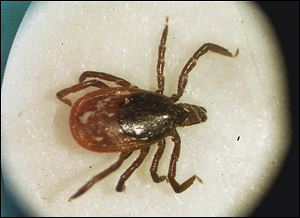
Ohio stops tracking insects
Scientists fear disease-spreaders won’t be monitored
4/29/2013
The Ohio Department of Health has told local officials that it no longer will provide lab testing for arthropods such as ticks, which can carry Lyme disease.
COLUMBUS — The elimination of bug surveillance at a state level has some experts and residents concerned about a gap in protecting public health, including monitoring the spread of ticks carrying Lyme disease.
“This leaves the state totally defenseless to know where blacklegged deer ticks are located in Ohio,” said Glen Needham, an associate professor of entomology at Ohio State University.
Deer ticks have spread from only a few counties to 26 in recent years and their prevalence is likely to lead to a surge in infections, he said.
It’s difficult to quantify the benefits of keeping tabs on ticks and warning residents about associated disease risk, Mr. Needham said.
“It’s hard to estimate prevention. How do you quantify a prevented disease?”
Earlier this month, the Ohio Department of Health told local health officials that it wouldn’t be providing lab analysis of insects, including mosquitoes and ticks, because of cuts in federal funding.
The state’s zoonotic-disease program also lost state funding in the most-recent budget. The state gave the program more than $642,000 in fiscal year 2011.
Richard Gary, the state’s public health entomologist, will stay on to consult with local health departments and others about vectors that transmit disease, and the state will continue to track human illness related to ticks, mosquitoes, and other insects, he said.
The state historically has tested about 1,000 ticks a year, although the number has varied, he said.
Columbus Public Health, like most local health departments, does not have an entomologist on staff and benefited from the state’s work identifying ticks, said Luke Jacobs, section chief for environmental health.
Staff members will continue to remind the public about measures to reduce tick exposure, including wearing light-colored clothing, including long pants and sleeves, and keeping lawns cut short, he said.
Ticks transmit a number of diseases including Lyme and Rocky Mountain spotted fever.
There were 93 reported cases of tick-borne illness in Ohio last year, including 67 cases of Lyme disease, Mr. Gary said.
The elimination of state surveillance is a concern, but it’s fortunate that there was some good work done to identify blacklegged ticks before the program ended, he said.
“But what is the next thing? And will we be ready for it? That’s my concern.”